Sewing instructor Elizabeth Searight posed outdoors with twelve female students wearing school uniforms.
Searight worked at the school from roughtly 1901 to 1915.

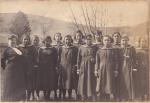
Sewing instructor Elizabeth Searight posed outdoors with twelve female students wearing school uniforms.
Searight worked at the school from roughtly 1901 to 1915.
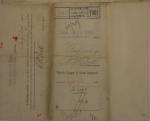
Richard H. Pratt submits a report that lists all school employees (W. B. Beitzel, Fannie I. Peter, S. J. Nori, W. H. Miller, Nellie V. Robertson, W. Grant Thompson, O. H. Bakeless, Kate S. Bowersox, Emma A. Cutter, Mariette Wood, Jessie W. Cook, Florence M. Carter, Fanny G. Paull, Jessie L. McIntire, Sadie E. Newcomer, Clara L. Smith, Margaret…
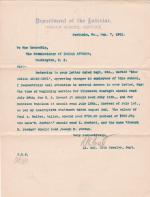
Richard Henry Pratt makes several corrections to an Office of Indian Affairs letter concerning changes to employees at the Carlisle Indian School.
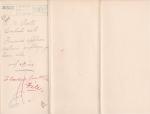
Richard H. Pratt forwards applications of three employees for leave of absence: Beckie L. Goodyear (assistant seamstress), Elizabeth Searight (assistant seamstress), and Mary E. Lininger (assistant seamstress).
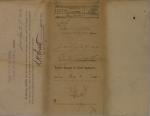
Lt. Colonel Richard H. Pratt submits a report that lists employees who have left the school (Josephine R. Walter, William Burgess, H. M. Robertson, O. T. Harris, S. W. Thompson, Rosa B. Brown, Mattie A. Harm, Dora M. Peters, and Lizzie C. Jacobs), those who have changed positions (E. G. Sprow, Howard E. Gansworth, and Elizabeth Searight), and…
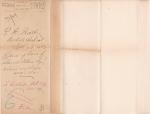
Richard Henry Pratt forwards fifty-one reports on leave of absence for several employees: Agnes May Robbins (teacher), Elizabeth E. Forster (drawing teacher), Etta S. Fortney (assistant laundress), Kate S. Bowersox (normal teacher), Beckie L. Goodyear (assistant seamstress), Mary E. Lininger (assistant seamstress), Ella G. Hill (laundry manager…
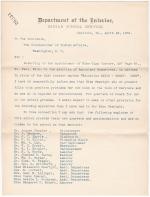
Richard Henry Pratt informs the Office of Indian Affairs that with the appointment of Olga Koerner that no provision for quarters or board are expected to be provided. Pratt also includes a list of employees who provide wither own quarters and accommodations.
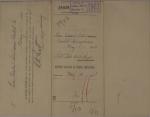
Colonel Richard H. Pratt submits a report that lists employees who have left the school (Mary Moffitt and Elizabeth Searight) and those who have changed positions (Olga O. Koerner). These reports include personal information about those being hired as well as reasons for departure for those leaving.
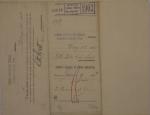
Superintendent Richard H. Pratt submits a report that lists employees who have left the school (Daisy C. Laird and Olga O. Koerner) and those who are new hires (Alice G. Turner and Elizabeth Searight). These reports include personal information about those being hired as well as reasons for departure for those leaving. Pratt also sends a…
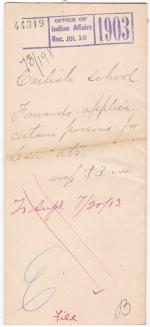
Edgar A. Allen (acting superintendent) forwards applications of three employees for leave of absence: E. Corbett (assistant seamstress), Susan Zeamer (assistant seamstress), and Elizabeth Searight (assistant seamstress).
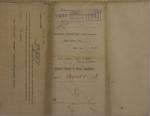
Colonel Richard H. Pratt submits a report that lists employees who have left the school (Elizabeth E. Forster, Jessie L. McIntire, Annie Belle Moore, Joseph Hummingbird, and Lila H. Connolly), those who have changed positions (William Davies, Florence M. Carter, and Margaret Roberts), and all employees working at the school to start the 1903-…
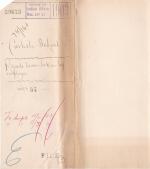
Edgar A. Allen (acting superintendent) forwards fifty-four reports on leave of absence several employees: Kate S. Bowersox (assistant principal and normal teacher), Margaret Roberts (teacher), Bertha Canfield (seamstress), Fanny G. Paull (teacher), Clara L. Smith (teacher), Anne H. Stewart (sloyd teacher), Elizabeth E. Forster (drawing teacher…
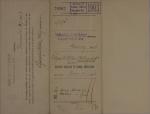
Acting Superintendent Edgar A. Allen submits a report that lists new employees (Etta White and Emma G. Sky), those who have left the school (Elizabeth Searight) and those who have changed positions (Howard E. Gansworth and Edith McHarg Steele). The report include the position title, salary, date of departure, and reason for departure.
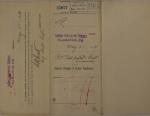
Richard H. Pratt submits a report that lists new employees (Elizabeth Searight and Bessie B. Beach), those who have left the school (Frank T. Reising and Etta White), and those who have changed positions (Beckie L. Goodyear). The reports include the position title, salary, date of departure, and reason for departure. Reising's letter of…
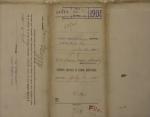
Major William A. Mercer submits a report that lists employees who have left the school (Jeannette L. Senseney, Emma G. Sky, Elizabeth Searight, Ida Boger, and George Brown Jr.) and all employees working at the school to start the 1905-1906 fiscal year. These reports include personal information about those being hired as well as reasons for…
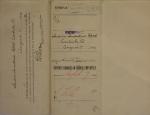
Major William A. Mercer submits a report that lists new employee (Elizabeth Searight) and employee who has left the school (E. Corbett). The report include position title, salary, date of departure, and reason for departure.
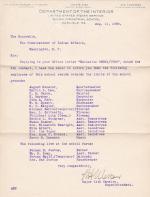
William A. Mercer forwards the names of staff who live outside the limits of the school grounds including staff who live on the school farm.
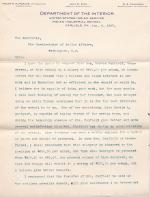
William A. Mercer requests the transfer of Bertha D. Canfield as seamstress and the promotion of Beckie L. Goodyear and Elizabeth Searight.
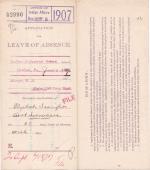
Major W. A. Mercer forwards Elizabeth Searight's application for a 30-day annual leave of absence. Searight works as an assistant seamstress.
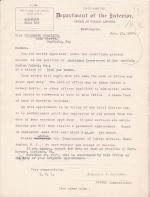
These materials include an appointment order for Elizabeth Searight as Assistant Seamstress at the Carlisle Indian School.
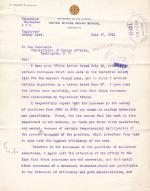
These materials include correspondence, an excerpt from an inspection report, and memoranda concerning staff organization and salary changes at the Carlisle Indian School. After an inspection by Charles F. Peirce, the salaries of certain employees were frozen and readjusted, and the organizational hierarchy of the school was revised.
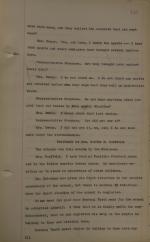
The typed transcript of Bertha Canfield's testimony before the Joint Commission to Investigate Indian Affairs. At the time Canfield oversaw the sewing room at the school.
In her testimony Canfield critiques the administration of Superintendent Friedman on the basis that he does not take any interest in the well-being or morality of the…
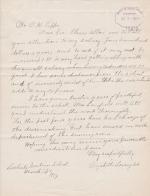
These materials include correspondence regarding requests from numerous employees for salary increases and on-campus housing provisions. During the 1914 Congressional Investigation, investigator Edward Linnen noted the need for salary increases for many employees, and for more on-campus housing to counter the high cost-of-living for employees…